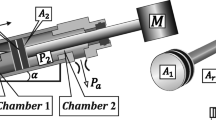Abstract
The paper deals with the principles of single-axis vibratory gyroscope operation. A mathematical model for a single-mass vibratory gyroscope and some modes of its operations are considered and relations between measured values (angle of rotation or angular rate) and sensitive mass generalized coordinates are described. Some details for the forced oscillations mode used in measuring of the angular rate and for two modes of natural oscillations used in measuring of the rotational angle and angular rate are described. A new method for identification of anisoelasticity in a single-axis vibratory gyroscope is suggested.
Similar content being viewed by others
References
V. V. Alexandrov, V. G. Boltyanskiy et al., Dynamics Optimization of Controllable Systems [in Russian], Izd. Mosk. Univ., Moscow (2000).
V. Apostolyuk and A. Zbrutsky, “Dynamics of a sensitive element of a micromechanical gyroscope,” Giroskopiya Navigaciya, No. 3 (22), 13–23 (1998).
R. E. Barnaby and J. B. Chatterton, “General theory and operational characteristics of the gyrotron angular rate tachometer,” Aeronautical Eng. Review, 12, No. 11, 31–36 (1953).
M. A. Barulina, V. E. Jashitov, and V. M. Pankratov, “Mathematical models for thermoregular systems for micromechanical gyroscopes,” Giroskopiya Navigaciya, No. 3 (37), 48–59 (2002).
D. I. Bugrov and A. A. Trusov, “Natural oscillations of a single-axis vibratory gyroscope,” Vestn. Mosk. Univ. Ser. 1 Mat. Mekh., No. 4, 65–66 (2004).
M. I. Evstifeev, “Errors of a micromechanical gyroscope on the vibrating base,” Giroskopiya Navigaciya, No. 2 (37), 19–25 (2002).
J. B. L. Foucault, “Demonstration physique au mouvement de rotation de la terre au moyen du pendule,” C. R. Acad. Sci. Paris, 32, 135–138 (1851).
B. Friedland and M. Hutton, “Theory and error analysis of vibrating-member gyroscope,” IEEE Trans. Autom. Contr., 23, No. 4, 545–556 (1978).
V. E. Jashitov, A. M. Lestev, V. M. Pankratov, and I. V. Popova, “Temperature and technological factors effect on precision of micromechanical gyroscopes,” Giroskopiya Navigaciya, No. 3 (26), 3–16 (1999).
S. G. Kucherkov, “Using of integrational properties of the vibratory micromechanical gyroscope with resonance,” Giroskopiya Navigaciya, No. 2 (37), 12–18 (2002).
A. M. Lestev, I. V. Popova, E. N. Pyatishev, M. S. Lurie, A. A. Semenov, and M. I. Evstifeev, “Development and investigation of the micromechanical gyroscope,” Giroskopiya Navigaciya, No. 2 (25), 3–10 (1999).
V. M. Morozov, Linear Time-Dependent Reducible Systems and Their Applications to Problems of Controllable Systems Mechanics [in Russian], Doctoral Dissertation in Physics and Mathematics, Moscow (1989).
E. Netzer and I. Porat, “A novel vibratory device for angular rate measurement,” J. Dynamic Systems, Measurement, and Control, 117, 585–591 (1995).
C. Painter and A. Shkel, “Identification of anisoelasticity for electrostatic “trimming” of rate integrating gyroscopes,” Proc. SPIE, No. 4700, 157–168 (2002).
C. Painter and A. Shkel, “Active structural error suppression in MEMS vibratory rate integrating gyroscopes,” IEEE Sensors J., 3, No. 5, 595–606 (2003).
C. Painter and A. Shkel, “Structural and thermal modeling of a z-axis rate integrating gyroscope,” J. Micromech. Microeng., 13, 229–237 (2003).
V. G. Peshehonov, “Gyroscopes at the beginning of the XXIst century,” in: Proc. Fourth Int. Aerospace Congress IAC’2003, 18–23 August 2003, Moscow, Russia, pp. 466–467.
A. Phani and A. Seshia, “Identification of anisoelasticity and nonproportional damping in MEMS gyroscopes,” NSTI-Nanotech, 2, 343–346 (2004).
A. Shkel, R. Horowitz, A. Seshia, S. Park, and R. Howe, “Dynamics and control of micromachined gyroscopes,” The Amer. Cont. Conf. (San Diego, CA), Vol. 3, 2119–2124 (1999).
A. Shkel, J. Lui, C. Ikei, and F.-G. Zeng, “Feasibility study on a prototype of vestibular implant using MEMS gyroscopes,” in: IEEE Int. Conf. on Sensors, Orlando, FL, USA, June 2002, paper 55.1, 1526–1531.
www.analogdevices.com.
V. F. Zhuravlev, “Theoretical bases for wave solid gyroscope,” Izv. Ross. Akad. Nauk, Mekh. Tverd. Tela, No. 3, 6–19 (1993).
V. F. Zhuravlev, “Controlled Foucault pendulum as a model for the class of free gyroscopes,” Izv. Ross. Akad. Nauk, Mekh. Tverd. Tela, No. 6, 27–35 (1997).
V. F. Zhuravlev, “The problem of error identification for a generalized Foucault pendulum,” Izv. Ross. Akad. Nauk, Mekh. Tverd. Tela, No. 5, 186–192 (2000).
V. F. Zhuravlev, “Generalized Foucault pendulum at an angle of precision control mode,” Izv. Ross. Akad. Nauk, Mekh. Tverd. Tela, No. 5, 3–7 (2002).
Author information
Authors and Affiliations
Additional information
__________
Translated from Fundamentalnaya i Prikladnaya Matematika, Vol. 11, No. 8, pp. 149–163, 2005.
Rights and permissions
About this article
Cite this article
Bugrov, D.I. Single-axis vibratory gyroscopes. J Math Sci 147, 6651–6661 (2007). https://doi.org/10.1007/s10958-007-0502-x
Issue Date:
DOI: https://doi.org/10.1007/s10958-007-0502-x




